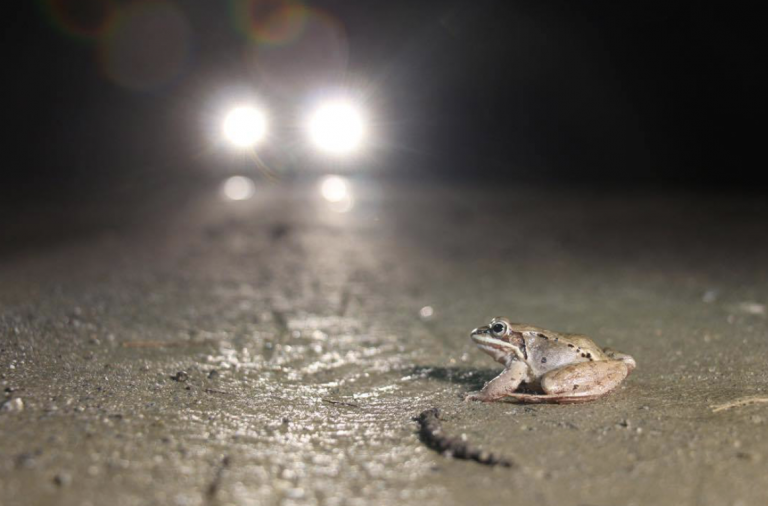Winterized Frogs About to Thaw Out and Get to Work
By TODD McLEISH/ecoRI News contributor
 |
| Wood frogs produce a natural antifreeze that allows them to almost freeze completely solid in winter. (Grace Kelly/ecoRI News) |
But this year, with traffic back to near normal levels, frogs and salamanders aren’t likely to fare as well. And wood frogs will likely be at the top of the list of roadkill victims.
In southern New England, wood frogs are one of the first signs of spring, according to herpetologist Mike Cavaliere, the Audubon Society of Rhode Island’s stewardship specialist. They are the first species to emerge from their winter hibernation, typically in mid to late March. And as soon as they awaken, he said, they hop to their breeding pools to seek a mate on the first night it rains.
“What’s particularly amazing about wood frogs is that they can produce a natural antifreeze that allows them to almost freeze completely solid in winter,” Cavaliere said. “This antifreeze is produced when the frogs start to feel ice crystals begin to form in late fall.”
Unique among frogs in the Northeast, the wood frog’s antifreeze is a chemical reaction between stored urine and glucose, which protects a frog’s cells and organs from freezing while allowing the rest of its body to freeze.
“Its brain shuts down, its heart stops, its lungs stop, everything stops for months. It’s like they’re in suspended animation,” Cavaliere said. “And once spring comes, they thaw out and the heart starts beating again. After about a day, they start hopping around, eating, and mating right away. It’s an amazing feat of evolution that they’ve developed.”
Wood frogs are often joined by spring peepers and spotted salamanders in migrating to their breeding pools during rainy nights in March, but it’s the frogs that are killed in the greatest numbers.
“Road mortality is one of the great seemingly unassessed sources of pressure for amphibians,” said Greg LeClair, a graduate student at the University of Maine who coordinates The Big Night, an amphibian monitoring project to quantify the roadkill of frogs and salamanders during their spring migration.
“We know that disease and climate are affecting amphibians, but road mortality has long been suspected to be a serious problem, though there is no data to quantify population declines.”
LeClair said road mortality can be as high as 100 percent in some areas when traffic is high during the one night of the season that most migration takes place.
“The average is 20 percent of amphibians at any road crossing will get nailed by a car in a given year,” he said. “That’s devastating for some species.”
During The Big Night, volunteers at 300 sites around Maine typically find two living amphibians crossing the road for every one dead one. But last year, with far fewer vehicles on the road because of the pandemic, twice as many frogs and salamanders survived the journey. In fact, a study by the Road Ecology Center found that pandemic lockdowns last year spared millions of animals from roadway deaths.
“We had record survival, but we’ll never be able to replicate that data again,” said LeClair, noting the impossibility of experimentally reducing region-wide traffic levels like happened with the pandemic.
While last year’s reduction in road mortality probably resulted in a short-term increase in amphibian populations, LeClair said that doesn’t mean there will be more breeding activity this year, since it takes several years for amphibians to grow to adulthood and begin breeding.
“It will take a couple years to determine if amphibian populations benefitted from the pandemic. My suspicion is leaning toward no benefit,” he said.
“Most amphibian populations are driven by juvenile survival more than adult survival, so impacts to juveniles have stronger impacts than impacts to adults. Dispersing juveniles last summer likely encountered normal-level traffic as they left the pool to find a territory.”
Whether wood frogs and other amphibians benefitted from the pandemic shutdowns, their increased survival rate last spring almost certainly benefitted other wildlife.
“Their eggs and tadpoles are a major food source for other animals in spring,” Cavaliere said. “It’s one of the first sources of protein available, so spotted turtles and other reptiles and amphibians will eat them, as will any other scavenger who’s hungry in spring and looking for protein.”
Those interested in helping scientists gather data about frog populations in Rhode Island should sign up to participate in FrogWatch through the Roger Williams Park Zoo. Online training for the program is available through March 31.
Rhode Island resident and author Todd McLeish runs a wildlife blog.
